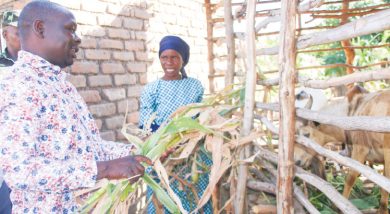Cooling makes milk business hotter
To milk producers, cooling is more essential than air conditioning in policymakers’ offices at Capital Hill.
Without refrigeration, livestock farmers around Linthipe 1 in Dedza and other remote trading centres sell milk at a loss—before it rots. Linthipe sits just under electricity transmission lines between Dedza Town and Lilongwe City, but has long been excluded from the grid. With a few getting connected lately, many locals are certain that access to energy is key to leaving no one behind.

Those who cannot wait to sell their milk before it perishes wonder why do they sell theirs at as low as K500 a litre when their neighbours at Dzaone Wekha Cooperative in the vicinity earn three times for the same quantity. The disparity shows the difference cooling makes to livelihoods of farmers struggling to break the poverty cycle.
But Sustainable Development Goal (SDG) seven—ensuring sustainable energy for all—could be the equaliser.
The desperation to sell the milk before it perishes personifies a widespread inequality slowing the global goals to end poverty by 2030.
Over 1.1 billion people globally live without access to cooling, according to a report released by Sustainable Energy for All (SEforAll) in July. Titled Chilling Prospects, the new evidence of risks and opportunities of cooling access show 470 million of the have-nots face worsening poverty in rural areas likely without access to electricity.
“Cooling is not a luxury. It’s a human right and fundamental issue of equity that underpins the ability of millions to escape poverty and realise SDGs,” said SEforAll chief executive officer Rachel Kyte when she unveiled the report at the United Nations (UN) High Level Political Forum on Sustainable Development, including SDG7.
Big business
Kyte is the special adviser of the UN secretary general on energy affairs.
She reckons energy must not just be evacuated to cities.
“Underneath the grid, we need distributed energy for the people, their agricultural enterprises, clinics and schools,” she says.
In the country, only a tenth of the population is connected, with rural areas underneath Electricity Supply Corporation of Malawi (Escom) wirework being disproportionately side-stepped. According to World Bank, only two percent of rural Malawians have electricity.
But there are limitless business opportunities for those that are connected to the grid and face up the challenge to put it to productive use.
Cooperative members at Dzaone Wekha, which literally means come and see, keep no secret about the wonders of improved cooling. The milk bulking group has a new plant which stores the milk in carefully controlled temperature until buyers from Lilongwe Diary Limited arrive.
“The amount of milk wasted has dropped enormously and keeping dairy cows has become big business in this area. People are quitting tobacco farming in preference for milk production. Milk pays back all year round while a tobacco farmer’s payday comes once a year,” says Kadauma Ntela, the clerk at the Dzaone Wekha.
Minimising losses
The bulking group comprises 256 members. They collect 30 000 litres a month, 10 times the volumes achieved in 1974 when government installed a small cooling plant.
Now, they have a bigger storage tank complete with machines for processing yoghurt and pasteurised milk, for value addition and higher incomes.
Donald Kazanga, an animal scientist at the Lilongwe University of Agriculture and Natural Resources, assisted the community in sourcing the plant from a South African firm. He is also part of a study the university is running to enhance capacity building for managing dairy cattle and climate change in the area.
“When I first met members of the cooperative, it was unmistakable that they needed reliable cooling to benefit from their hard work. With cooling, you minimise the losses of milk.”
According to Lilongwe Dairy Limited general manager Edwin Chilundo, up to 12 percent of milk was going to waste due to persistent power cuts, especially in the Southern Region. Improved cooling facilities have reduced the wastage rate to three percent.
Ramp up prices
Dzaone Wekha chairperson Rodrick Kambuku says the cooperative no longer throw away their creamy gold except when there is long blackout.
“Now we have a bigger tank. We no longer worry that our milk will rot before the buyer from Lilongwe Diary comes calling.
“We are mainly worried about prices. It costs about K250 to care for a cow to produce a litre the sole buyers gets at K155. They tell us that they don’t benefit much of high tax, but we feel government is not doing much to uplift dairy farming.”
The farmers want government to scrape the tax and expand markets for milk, which contribute almost K6.4 billion to the economy annually.
“Crop growers sell their yield to Agricultural Development and Marketing Corporation [Admarc], AHL Group and National Food Reserve Agency, but livestock farmers have no single State-run marketing agency as if agriculture is just about crop production,” says Golden Kalinde, an artificial inseminator.
The father of three no longer produces tobacco, the main forex earner, on his two-acre crop field where he now grows maize and groundnuts. He is convinced the leaf impoverishes farmers and “slowly kills the nation” while milk improves incomes, nutrition and health. n





